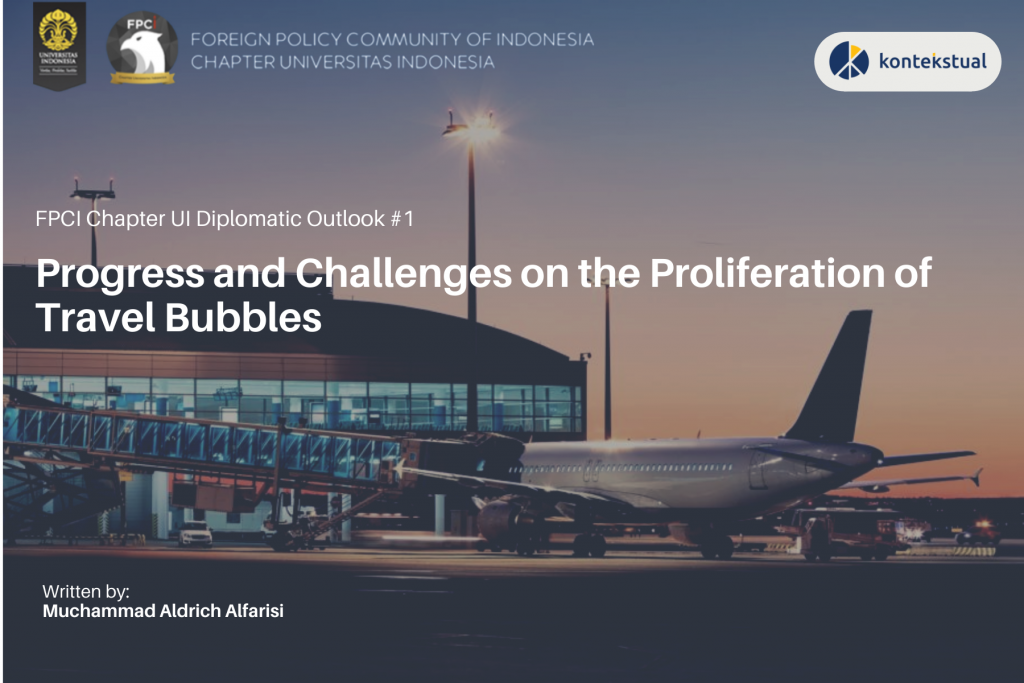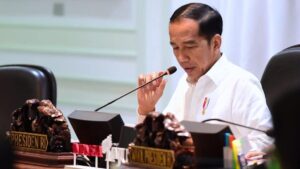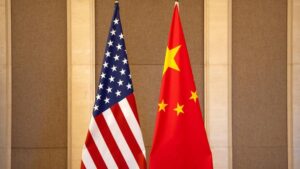Progress and Challenges on The Proliferation of Travel Bubbles

Illustration from FPCI UI
Despite the growing trends and positive progress of vaccination among countries in the second year of the global pandemic, recent outbreaks around the world are still ravaging some sectors of human life in a problematic manner. One of the sectors that are deeply impacted and are still trying to stand back on its feet is the travel and tourism industry. According to a report released by the UNWTO (The World Tourism Organization) explaining the impact assessment of the pandemic on international tourism, travel restriction and border closing around the globe would cause 70% decline of international tourism for the whole of 2020. This decline is estimated to be equivalent to US $2 trillion of economic loss in global GDP. Nevertheless, there are efforts by several countries to recover from the aforementioned problem. One of these efforts is the travel bubble strategy that is expected to keep the tourism industry afloat and gradually rebuild the economies of nations following the trend of economic recovery.
The Progress of Travel Bubbles Around the World
First of all, we need to understand how travel bubbles have worked out so far. Travel bubbles alliance between neighbouring countries with low infection rates to initiate a quarantine-free travel between those countries. Certain nations around the globe have implemented the travel bubble strategy since the midst of 2020 with mixed results. One of the pioneers to carry out the strategy are New Zealand and Australia with their “Trans-Tasman Bubble”, announced in May 2020. New Zealand, with their well-executed lockdown initiatives and a record of low cases of infections, raises hope to the world of a successful strategy in efforts of an economic recoverment. However, with unstable domestic conditions and a series of snap lockdowns in signs of a new outbreak in the region, one of recent happened in May 2021 with the emergence of two new COVID cases in Sydney, caused the strategy to recover arduously between the two countries.
Another region that had undertaken the travel bubble strategy is the European Union with its initiative named “Re-open EU” which began in May 2020 by some Baltic States which was soon followed by the Schengen Area and Britain. This travel bubble used a “red-orange-green colour system” assigned to countries who then helped them coordinate its policy with others. However, a case of bubble “burst” happened in July 2020 where British travelers visiting Spain were disrupted by re-establishment of the 14 days quarantine rule back home following a spike of positive cases in Spain thus forcing the travelers to end their holidays early or face the quarantine treatment from the government. Similar to the previously discussed bubble, disruptions occurred throughout the implementation of the EU bubble. Nevertheless, the EU initiative doesn’t show any sign of stopping and plans have been created to expand the bubble to travellers from the US and other partnered countries in welcoming the 2021 summer season of tourism in Europe. The partnered countries also didn’t waste any time to set up their own travel bubble strategy in 2021, among them, in the regions of Asia, are Singapore and Hong Kong with their air travel bubble which is set to take-off on 26th of May 2021 according to the latest updates.
Commentaries Revolving the Travel Bubble
Considering how travel bubbles have worked out since their emergence in the midst of 2020, arguments have risen revolving around the effectiveness and implications of travel bubbles as a solution to maintain the tourism industry and the overall economy. Some arguments have been welcoming the strategy as a means of regaining the loss during the early phase of the pandemic, others have been cautious of the strategy, pointing out risks and additional considerations for a better implementation.
One of the positive arguments of the travel bubble of New Zealand and Australia mentions that “Despite its risks, the announced introduction of quarantine-free travel is a manageable and large potential benefits could be harvested from the new arrangement,” stated by Professor Michael Baker, Professor of Public Health in University of Otago, Wellington. The new arrangement would open up opportunities between the two countries for more research and evaluation, shared learning, and improvements across the region. Another benefit of the arrangement is to lay models of successful international collaboration of effective public health measures and vaccines in managing COVID-19, thus opening up the possibility of eliminating COVID-19 across large areas for the world to imitate.
Another side of the arguments presented by Dr. David Beirman, senior lecturer in Tourism in the Management Discipline Group, University of Technology Sydney, reflecting the bubble burst between Britain and Spain in July 2020 shows the fragility of strategy. Dr. David stated that, “There is a potential danger in prioritising economic needs to revitalise tourism in choosing a travel bubble ahead of addressing health and safety risks. The situation which arose between the UK and Spain is a salutary warning to avoid hasty decisions about ‘Corona corridors’ which could spread the pandemic. Globally, 35% of COVID-19 cases are linked to tourism.” It can be interpreted that even though travel bubbles can be a solution to tackle economic problems during the pandemic, governments are still unable to safely contain the spread of the virus and health concerns would remain a priority above economic concerns.
Writer’s Opinion and Conclusion
From the information and arguments above, it can be inferred that travel bubble strategy is one of the ways that can be used by some countries to nurture back their travel conditions in hopes of regaining the loss of growth in their tourism industry and economy. There are certain gains and risks revolving around the strategy with considerations of domestic preparedness in receiving foreign travelers, partner nation’s conditions and policy, and contingency plans in case of a new potential outbreak. Until now, several runs have been made to launch them, yet most of them have been facing pauses and disruptions in their implementations. Nevertheless, despite the risks brought by this method, many other countries are planning to carry out their version of the travel bubble strategy in efforts to catch up the trend of economic recovery. We can conclude that this strategy would remain as one of the global means to recover from the crisis brought by the pandemic.
References can be accessed through http://bit.ly/DipLookTravelBubblesReferences
Muchammad Aldrich Alfarisi is one of the staff of Research and Analysis Division in FPCI Chapter UI Board of 2021. He can be found on Instagram with the username @aldrich.lf





